|
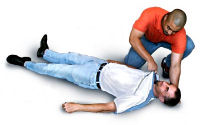 Breathing
difficulties Breathing
difficulties
If an adult is unconscious, see if they
are breathing. If not, start artificial respiration
as described below.
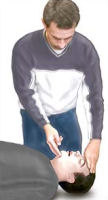 When
someone has stopped breathing, see if the person responds
by talking to them or shaking them by the shoulder. If not,
call an ambulance (if possible) and then begin first aid treatment. When
someone has stopped breathing, see if the person responds
by talking to them or shaking them by the shoulder. If not,
call an ambulance (if possible) and then begin first aid treatment.
First, place the casualty flat on his or her back on the floor.
Tilt the head so that the chin is pointing upwards by placing
your fingertips under the jawbone, then lift gently while
pressing down softly on the person's forehead. This ensures
that the tongue is not blocking the throat.
Keep holding the head in this way while checking for breathing:
see if the chest is rising and falling, or place your ear
next to their mouth to listen for breathing.
If there is breathing, hold the head as described above until
help arrives. If not, start Cardio-Pulmonary Resuscitation
(CPR).
NOTE:
Mouth-to-mouth resuscitation is no longer recommended in CPR
because studies have shown that continuous chest compressions
alone are just as effective, if not more so, than adding rescue
breaths, and doing so avoids interrupting life-saving compressions,
reduces the risk of disease transmission, and encourages more
people to perform CPR by eliminating the hesitation associated
with mouth-to-mouth contact with a stranger; this approach
is often referred to as "hands-only CPR.".
Checking
for a pulse
If an
adult is unconscious and has no pulse. If you are inexperienced,
you may waste valuable time checking for a pulse.
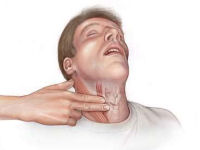 |
How to take a pulse:
-
Place
your fingers in the groove between the windpipe
and the muscles of the side of the neck.
-
Press
backwards here to check for a pulse.
-
If
there is no pulse, or if you are unsure, then proceed
with CPR without delay as follows:
|
CardioPulmonary
Resuscitation (CPR)
Look at the person's chest and find the 'upside-down V' shaped
notch that is made by the lower edge of the ribcage. Place
your middle finger in this notch and then place your index
finger beside it, resting on the breastbone.
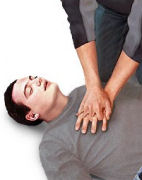 Take
the heel of your other hand and slide it down the breastbone
until it is touching this index finger. The heel of your hand
should now be positioned on the middle of the lower half of
the breastbone. Take
the heel of your other hand and slide it down the breastbone
until it is touching this index finger. The heel of your hand
should now be positioned on the middle of the lower half of
the breastbone.
Now place the heel of your other hand on top of the first.
Keep your fingers off the chest, by locking them together.
Pressure should be applied through the heels of the hands
only.
Keep your elbows straight, and bring your body weight over
your hands to make it easier to press down.
Press down firmly and quickly to achieve a downwards movement
of 4-5cm, then relax and repeat the compression.
Do this 15 times, then give artificial respiration twice.
Continue this 15:2 procedure until help arrives.
Aim for a rate of compression of about 100 per minute. You
can help your timing and counting by saying out loud 'one
and two and three and four ...' etc.
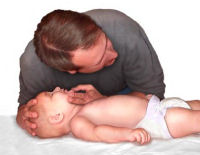 If
a baby (up to 1 year) is unconscious and has no pulse: If
a baby (up to 1 year) is unconscious and has no pulse:
Find the place between the nipples where the ribs meet in
the breastbone. Move your fingers about 2cm to the right from
this point - just above their heart.
Press firmly, but not forcefully, with your index and middle
fingers.
If you can't see the baby's chest rise, the pressure is not
correct. But with babies, it is especially important to prevent
further injury by taking care not to press too hard.
The basic CPR steps should be performed in the following
order:
- STEP
1: CALL 999. First, call 999 or ask a bystander to do so.
- STEP
2: ASSESS THE SCENE.
- STEP
3: PERFORM A BREATHING CHECK.
- STEP
4: CHECK FOR A PULSE.
- STEP
5: BEGIN CHEST COMPRESSIONS.
- STEP
6: GIVE RESCUE BREATHS.
- STEP
7: CONTINUE CPR UNTIL HELP ARRIVES.
 Bleeding Bleeding
With all
types of bleeding, it's important to stop the flow of blood
as quickly as possible.
Small
cuts
Small
cuts in the veins stop bleeding and clot within a few minutes.
The area should then be washed, and a plaster placed gently
on top.
Deeper cuts
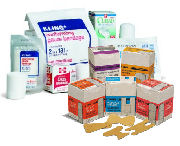 Bleeding
from most injuries can be stopped by applying direct pressure
to the injury. This keeps from cutting off the blood supply
to the affected limb. Bleeding
from most injuries can be stopped by applying direct pressure
to the injury. This keeps from cutting off the blood supply
to the affected limb.
Deeper cuts in the veins produce dark blood that seeps out
slowly and steadily. It can be stopped by gentle pressure
on the wound with a sterile or clean cloth, followed by the
application of a clean or sterile bandage.
Often,
these wounds need sewing or glueing, and therefore medical
treatment will be necessary after first aid.
Arterial
bleeding
Note: Arterial bleeding must always be referred to a doctor.
Bleeding from an artery can cause death within a few minutes,
so urgent first aid is essential. This type of bleeding pulsates
and squirts blood as the pulse beats. The blood is often a
light red colour.
 To
stop bleeding from an artery: To
stop bleeding from an artery:
- apply
hard pressure on the wound and keep this up until the patient
receives medical treatment.
- press
with a sterile cloth or just use your hand if nothing else
is available.
- put
a bandage on the wound if possible. If the blood soaks through
the bandages, press harder until the bleeding stops.
- do
not remove the soaked bandages, but place another on top
if necessary.
- do
not attempt to clean the wound.
- The
person must be made to lie down, preferably with their head
lower than the rest of their body. This will ensure that
enough oxygen gets to the brain.
- If
possible, position the wounded area higher than the rest
of their body so that the pressure, and therefore the bleeding,
will be reduced.
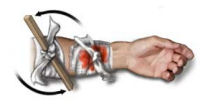 When
there is severe bleeding where a major artery has been severed,
pressure may be insufficient and a tourniquet may be necessary. When
there is severe bleeding where a major artery has been severed,
pressure may be insufficient and a tourniquet may be necessary.
Tourniquets are an effective way of stopping bleeding from
an extremity. They do, however, stop circulation to the affected
extremity and should ONLY be used when other methods, such
as pressure dressings, have failed (or are likely to fail).
Pressure from tourniquets must be relieved periodically to
prevent damage to the tissue from lack of oxygen.
Note: Tourniquets should only be used as a last resort
if the bleeding cannot be stopped and the situation is life
threatening.

Nosebleeds
Nosebleeds occur when one of the small blood vessels in
the mucous membranes of the nose bursts.
Most nosebleeds look much worse than they really are. Almost
all nosebleeds can be treated easily
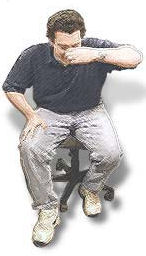 If
you or someone else does suffer a nosebleed do not bend the
head backwards or lie down, because this increases blood pressure
in the head and so increases the bleeding. Keeping your head
above your heart will make your nose bleed less. Blood may
also run into the stomach. If
you or someone else does suffer a nosebleed do not bend the
head backwards or lie down, because this increases blood pressure
in the head and so increases the bleeding. Keeping your head
above your heart will make your nose bleed less. Blood may
also run into the stomach.
To limit the bleeding:
- if
possible, sit down and lean forward
- pinch
the nostrils shut with the index and middle finger for 10
minutes. This way, the vein is pressed together, which is
often enough to stem the flow.
- while
the nostrils are shut, the person must breathe through their
mouth.
- if
the bleeding continues, it is important to contact a doctor.
If the
person frequently suffers sudden, intense nosebleeds, they
should also consult a doctor.
Choking
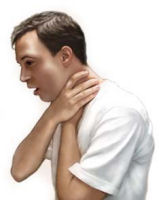 Choking
happens when the passage through the windpipe is blocked.
This usually occurs when food that has not been thoroughly
chewed gets stuck. Choking
happens when the passage through the windpipe is blocked.
This usually occurs when food that has not been thoroughly
chewed gets stuck.
If someone looks like they are choking, ask them if they are
able to talk.
A person who is genuinely choking can usually only communicate
with hand movements, and may place their hand against their
throat. In such a case they will definitely need help, so
summon assistance for them.
Provided the person is conscious and breathing, you should
not interfere. However, be prepared to do so if the obstruction
appears to become complete or markedly worse.
The best way to relieve choking is by using the Heimlich manoeuvre:

The Heimlich manoeuvre
- Stand
behind the person who is choking.
- Place
your arms around their waist and bend them well forward.
- Clench
your fist and place it right above the person's navel (belly
button).
- Place
your other hand on top, then thrust both hands backwards
into the stomach with a hard, upward movement.
- Repeat
this until the object stuck in the throat is expelled through
their mouth.
- If
you need to carry out this manoeuvre on yourself, place
a clenched hand above your navel (belly button) and your
other hand on top. Then thrust your fist hard into your
stomach.
- Repeat
this until the object stuck in the throat is expelled through
the mouth.
Shock
and fainting
Shock
and fainting occur when only a small amount of blood circulates
to the brain. This means that the brain is not receiving enough
oxygen, which leads to a feeling of faintness, disorientation
and dizziness.
Shock
may also occur:
- after
an accident involving loss of blood.
- after
a serious infection with loss of fluids.
- after
a serious burn.
- after
other accidents that cause loss of fluids or blood.
- When
the flow of blood in the body is too slow, the blood pressure
drops and too little oxygen is circulated through the body.
 When
this occurs a person will: When
this occurs a person will:
- go
pale
- turn
sweaty, clammy and cold
- become
dizzy
- have
a weak, fast pulse
- have
low blood pressure
- have
slow, weak breathing
- lose
consciousness
- become
anxious or restless.
What
to do if someone is in shock or fainting:
The person must lie on their back - preferably with their
feet raised - to ensure enough blood gets to the brain.
Make sure the person is warm, comfortable and covered by a
blanket if possible.
Do not give them anything to drink because they could run
a risk of choking.
If the person vomits or bleeds from the mouth, he or she must
be placed on their side to prevent choking.
Call for an ambulance. A person in shock must always be treated
by a doctor.
 Fractures
(broken bones) Fractures
(broken bones)
A fracture is a break in a bone. If the broken bone punctures
the skin, it is called an open or compound fracture. Fractures
commonly happen because of various accidents such as car accidents,
falls or sports injuries.
Symptoms
of a fracture are:
- Out-of-place
or misshapen limb or joint
- Swelling,
bruising or bleeding
- Intense
pain
- Numbness
and tingling
- Limited
mobility or inability to move a limb
You need
to get medical care as soon as possible for any fracture.
Very often the limb needs to be immobilised in a cast or splint.
Sometimes surgery is required to put in plates, pins or screws
to keep the bone in place.
If a fracture should occur or is suspected take these actions
immediately while waiting for medical help:
- Stop
any bleeding. Apply pressure to the wound with a sterile
bandage, a clean cloth or a clean piece of clothing.
- Immobilize
the injured area. Don't try to realign the bone, but if
you've been trained in how to splint and professional help
isn't readily available, apply a splint to the area.
- Apply
ice packs to limit swelling and help relieve pain until
emergency personnel arrive. Don't apply ice directly to
the skin — wrap the ice in a towel, piece of cloth
or some other material.
- Treat
for shock. If the person feels faint or is breathing in
short, rapid breaths, lay the person down with the head
slightly lower than the trunk and, if possible, elevate
the legs.
|